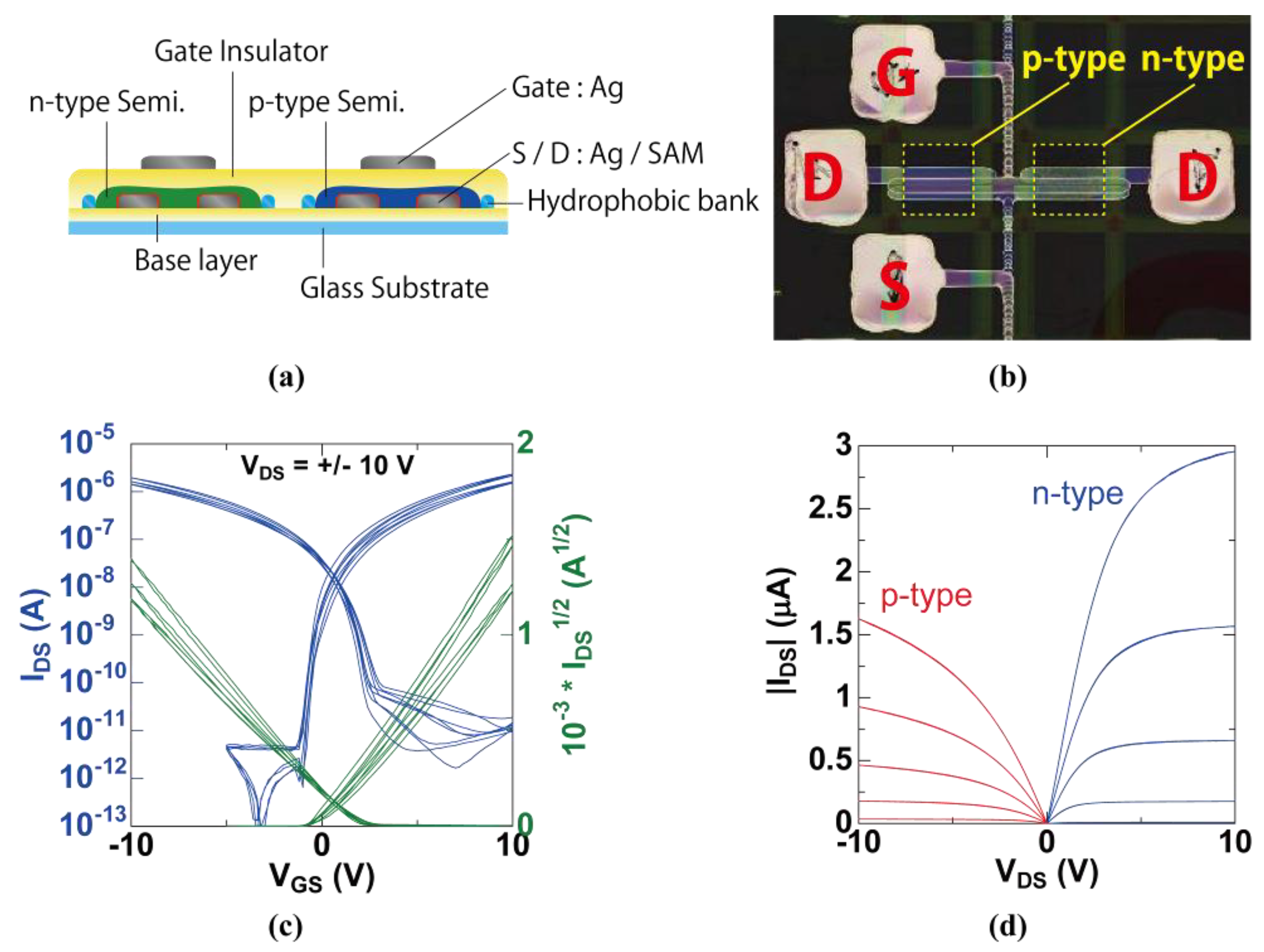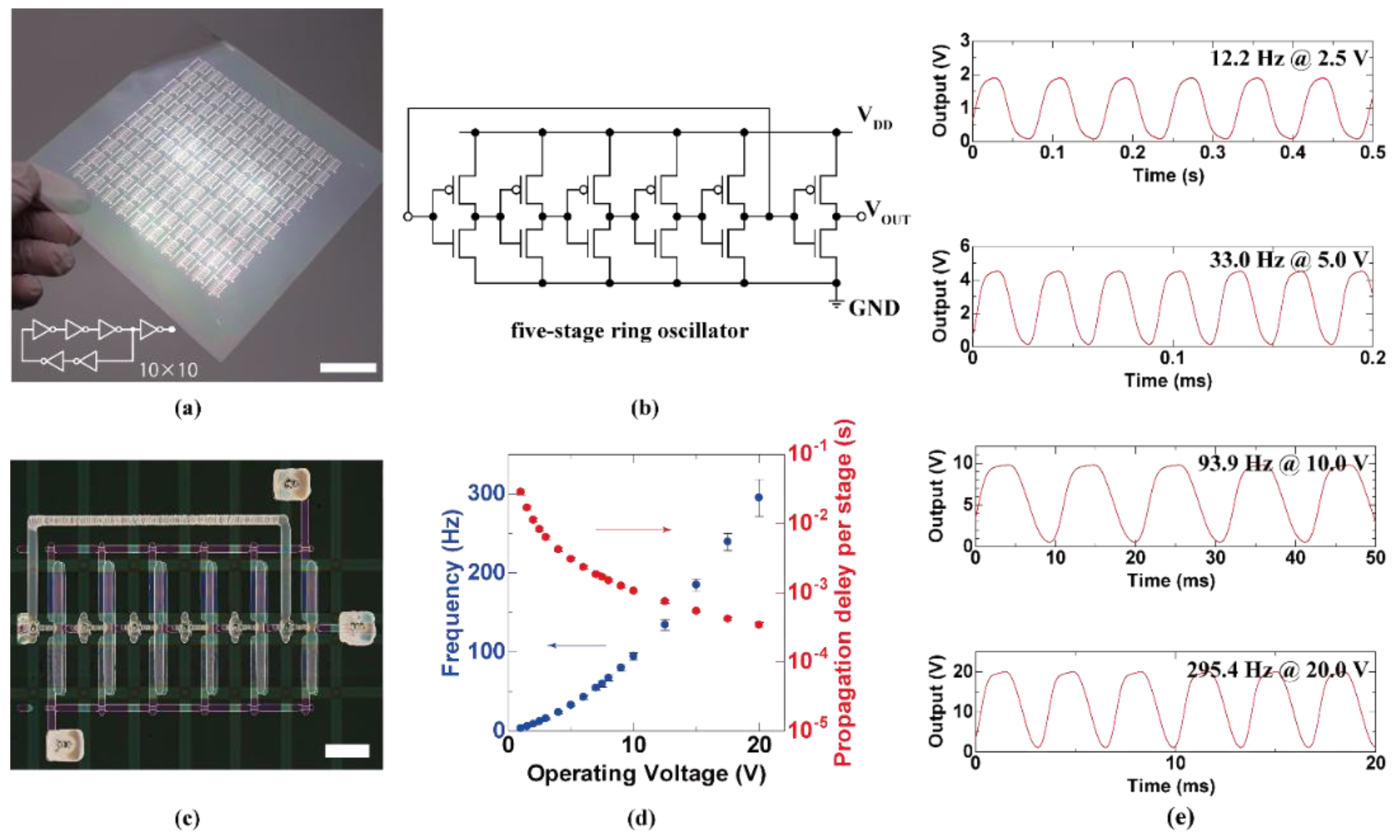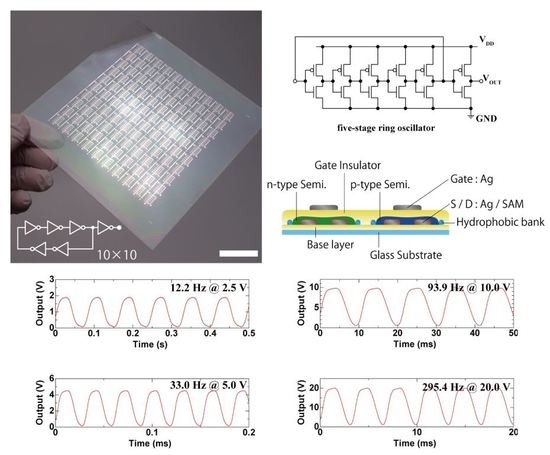Printed Organic Complementary Inverter with Single SAM Process Using a p-type D-A Polymer Semiconductor
Abstract
:Featured Application
Abstract
1. Introduction
2. Materials and Methods
2.1. Device Fabrication
2.2. Material Inks
2.3. Complementary Integrated Circuit Fabrication Process
2.4. Device Characterization
3. Results
3.1. Fabrication of TGBC Structure Organic Complementary Integrated Circuits and OTFT Characteristics
3.2. Electrical Performances of Organic Complementary Integrated Inverter Circuits
3.3. Fabrication and Characterization of Organic Complementary Ring Oscillator Array
4. Conclusions
Author Contributions
Funding
Acknowledgments
Conflicts of Interest
References
- Schwartz, G.; Tee, B.C.-K.; Mei, J.; Appleton, A.L.; Kim, D.H.; Wang, H.; Bao, Z. Flexible Polymer Transistors with High Pressure Sensitivity for Application in Electronic Skin and Health Monitoring. Nat. Commun. 2013, 4. [Google Scholar] [CrossRef] [PubMed]
- Yao, Y.; Dong, H.; Hu, W. Charge Transport in Organic and Polymeric Semiconductors for Flexible and Stretchable Devices. Adv. Mater. 2015, 28, 4513–4523. [Google Scholar] [CrossRef] [PubMed]
- Pastorelli, F.; Schmidt, T.M.; Hösel, M.; Søndergaard, R.R.; Jørgensen, M.; Krebs, F.C. The Organic Power Transistor: Roll-to-roll manufacture, thermal behavior, and power handling when driving printed electronics. Adv. Eng. Mater. 2016, 18, 51–55. [Google Scholar] [CrossRef] [Green Version]
- Vilkman, M.; Hassinen, T.; Keränen, M.; Pretot, R.; van der Schaaf, P.; Ruotsalainen, T.; Sandberg, H.G.O. Fully Roll-to-Roll Processed Organic Top Gate Transistors Using a Printable Etchant for Bottom Electrode Patterning. Org. Electron. 2015, 20, 8–14. [Google Scholar] [CrossRef]
- Homenick, C.M.; James, R.; Lopinski, G.P.; Dunford, J.; Sun, J.; Park, H.; Jung, Y.; Cho, G.; Malenfant, P.R.L. Fully Printed and Encapsulated SWCNT-Based Thin Film Transistors via a Combination of R2R Gravure and Inkjet Printing. ACS Appl. Mater. Interfaces 2016, 8, 27900–27910. [Google Scholar] [CrossRef] [PubMed] [Green Version]
- Vornbrock, F.; Sung, D.; Kang, H.; Kitsomboonloha, R.; Subramanian, V. Fully Gravure and Ink-Jet Printed High Speed pBTTT Organic Thin Film Transistors. Org. Electron. 2010, 11, 2037–2044. [Google Scholar] [CrossRef]
- Vaillancourt, J.; Zhang, H.; Vasinajindakaw, P.; Xia, H.; Lu, X.; Han, X.; Janzen, D.C.; Shih, W.-S.; Jones, C.S.; Stroder, M.; et al. All Ink-Jet-Printed Carbon Nanotube Thin-Film Transistor on a Polyimide Substrate with an Ultrahigh Operating Frequency of Over 5 GHz. Appl. Phys. Lett. 2008, 93, 243301. [Google Scholar] [CrossRef]
- Arias, A.C.; Ready, S.E.; Lujan, R.; Wong, W.S.; Paul, K.E.; Salleo, A.; Chabinyc, M.L.; Apte, R.; Wu, Y.; Liu, P.; et al. All Jet-Printed Polymer Thin-Film Transistor Active-Matrix Backplanes. Appl. Phys. Lett. 2004, 85, 3304–3306. [Google Scholar] [CrossRef]
- Kim, D.; Lee, S.H.; Jeong, S.; Moon, J. All-Ink-Jet Printed Flexible Organic Thin-Film Transistors on Plastic Substrates. Electrochem. Solid-State Lett. 2009, 12, H195–H197. [Google Scholar] [CrossRef]
- Chung, S.; Kim, S.O.; Kwon, S.-K.; Lee, C.; Hong, Y. All-Inkjet-Printed Organic Thin-Film Transistor Inverter on Flexible Plastic Substrate. IEEE Electron. Dev. Lett. 2011, 32, 1134–1136. [Google Scholar] [CrossRef]
- Tseng, H.-Y.; Subramanian, V. All Inkjet-Printed, fully Self-Aligned Transistors for Low-Cost Circuit Applications. Org. Electron. 2011, 12, 249–256. [Google Scholar] [CrossRef]
- Tobjörk, D.; Kaihovirta, N.J.; Mäkelä, T.; Pettersson, F.S.; Österbacka, R. All-Printed Low-Voltage Organic Transistors. Org. Electron. 2008, 9, 931–935. [Google Scholar] [CrossRef]
- Klauk, H.; Zschieschang, U.; Pflaum, J.; Halik, M. Ultralow-Power Organic Complementary Circuits. Nature 2007, 445, 745–748. [Google Scholar] [CrossRef] [PubMed]
- Baeg, K.-J.; Khim, D.; Kim, D.-Y.; Jung, S.-W.; Koo, J.B.; You, I.-K.; Yan, H.; Facchetti, A.; Noh, Y.-Y. High Speeds Complementary Integrated Circuits Fabricated with All-Printed Polymeric Semiconductors. Polym. Sci. Part B Polym. Phys. 2011, 49, 62–67. [Google Scholar] [CrossRef]
- Takeda, Y.; Yoshimura, Y.; Shiwaku, R.; Hayasaka, K.; Sekine, T.; Okamoto, T.; Matsui, H.; Kumaki, D.; Katayama, Y.; Tokito, S. Organic Complementary Inverter Circuits Fabricated with Reverse Offset Printing. Adv. Electron. Mater. 2018, 4, 1700313. [Google Scholar] [CrossRef]
- Kwon, J.; Takeda, Y.; Fukuda, K.; Cho, K.; Tokito, S.; Jung, S. Three-Dimensional, Inkjet-Printed Organic Transistors and Integrated Circuits with 100% Yield, High-Uniformity and Long-Term Stability. ACS Nano 2016, 10, 10324–10330. [Google Scholar] [CrossRef] [PubMed]
- Hayasaka, K.; Matsui, H.; Takeda, Y.; Shiwaku, R.; Tanaka, Y.; Shiba, T.; Kumaki, D.; Tokito, S. Compact Organic Complementary D-Type Flip-Flop Circuits Fabricated with Inkjet Printing. Adv. Electron. Mater. 2017, 3, 1700208. [Google Scholar] [CrossRef]
- Takeda, Y.; Hayasaka, K.; Shiwaku, R.; Yokosawa, K.; Shiba, T.; Mamada, M.; Kumaki, D.; Fukuda, K.; Tokito, S. Fabrication of Ultra-Thin Printed Organic TFT CMOS Logic Circuits Optimized for Low-Voltage Wearable Sensor Applications. Sci. Rep. 2016, 6, 25714. [Google Scholar] [CrossRef] [PubMed] [Green Version]
- Kwon, J.; Takeda, Y.; Fukuda, K.; Cho, K.; Tokito, S.; Jung, S. Vertically Stacked Complementary Organic Field-Effect Transistors and Logic Circuits Fabricated by Inkjet-Printing. Adv. Electron. Mater. 2016, 2, 1600046. [Google Scholar] [CrossRef]
- Takeda, Y.; Yoshimura, Y.; Kobayashi, Y.; Kumaki, D.; Fukuda, K.; Tokito, S. Integrated Circuits Using Fully Solution-Processed Organic TFT Devices with Printed Silver Electrodes. Org. Electron. 2013, 14, 3362–3370. [Google Scholar] [CrossRef]
- Fukuda, K.; Sekine, T.; Kumaki, D.; Tokito, S. Profile Control of Inkjet Printed Silver Electrodes and their Application to Organic Transistors. ACS Appl. Mater. Interfaces 2013, 5, 3916–3920. [Google Scholar] [CrossRef] [PubMed]
- Kim, D.; Jeong, S.; Park, B.K.; Moon, J. Direct Writing of Silver Conductive Patterns: Improvement of Film Morphology and Conductance by Controlling Solvent Compositions. J. Appl. Phys. Lett. 2006, 89, 264101. [Google Scholar] [CrossRef]
- Ying, L.; Hsu, B.-B.Y.; Zhan, H.; Welch, G.C.; Zalar, P.; Perez, L.A.; Kramer, E.J.; Nguyen, T.-Q.; Heeger, A.J.; Wong, W.-Y.; Bazan, G.C. Regioregular Pyridal[2,1,3]thiadiazole π-Conjugated Copolymers. J. Am. Chem. Soc. 2011, 133, 18538–18541. [Google Scholar] [CrossRef] [PubMed]
- Tseng, H.R.; Phan, H.; Luo, C.; Wang, M.; Perez, L.A.; Patel, S.N.; Ying, L.; Kramer, E.J.; Nguyen, T.-Q.; Bazan, G.C.; et al. High-Mobility Field-Effect Transistors Fabricated with Macroscopic Aligned Semiconducting Polymers. Adv. Mater. 2014, 26, 2993–2998. [Google Scholar] [CrossRef] [PubMed]
- Wang, M.; Ford, M.; Phan, H.; Coughlin, J.; Nguyen, T.-Q.; Bazan, G.C. Fluorine Substitution Influence on Benzo[2,1,3]thiadiazole Based Polymers for Field-Effect Transistor Applications. Chem. Commun. 2016, 52, 3207–3210. [Google Scholar] [CrossRef] [PubMed]
- Wang, M.; Ford, M.J.; Zhou, C.; Seifrid, M.; Nguyen, T.-Q.; Bazan, G.C. Linear Conjugated Polymer Backbones Improve Alignment in Nanogroove-Assisted Organic Field-Effect Transistors. J. Am. Chem. Soc. 2017, 139, 17624–17631. [Google Scholar] [CrossRef] [PubMed]
- Mamada, M.; Shima, H.; Yoneda, Y.; Shimano, T.; Yamada, N.; Kakita, K.; Machida, T.; Tanaka, Y.; Aotsuka, S.; Kumaki, D.; et al. A Unique Solution-Processable n-type Semiconductor Material Design for High-Performance Organic Field-Effect Transistors. Chem. Mater. 2015, 27, 141–147. [Google Scholar] [CrossRef]




| Operating Voltage (V) | Gain | Switching Point Forward/Reverse (V) | Noise Margin (V) |
|---|---|---|---|
| 2.5 | 2.3 | 1.5/1.4 | 0.19 (15%) |
| 5.0 | 4.3 | 2.6/2.4 | 0.73 (29%) |
| 7.5 | 8.2 | 3.5/3.4 | 1.34 (36%) |
| 10.0 | 8.9 | 4.8/4.4 | 1.96 (39%) |
© 2018 by the authors. Licensee MDPI, Basel, Switzerland. This article is an open access article distributed under the terms and conditions of the Creative Commons Attribution (CC BY) license (http://creativecommons.org/licenses/by/4.0/).
Share and Cite
Takeda, Y.; Sekine, T.; Shiwaku, R.; Murase, T.; Matsui, H.; Kumaki, D.; Tokito, S. Printed Organic Complementary Inverter with Single SAM Process Using a p-type D-A Polymer Semiconductor. Appl. Sci. 2018, 8, 1331. https://doi.org/10.3390/app8081331
Takeda Y, Sekine T, Shiwaku R, Murase T, Matsui H, Kumaki D, Tokito S. Printed Organic Complementary Inverter with Single SAM Process Using a p-type D-A Polymer Semiconductor. Applied Sciences. 2018; 8(8):1331. https://doi.org/10.3390/app8081331
Chicago/Turabian StyleTakeda, Yasunori, Tomohito Sekine, Rei Shiwaku, Tomohide Murase, Hiroyuki Matsui, Daisuke Kumaki, and Shizuo Tokito. 2018. "Printed Organic Complementary Inverter with Single SAM Process Using a p-type D-A Polymer Semiconductor" Applied Sciences 8, no. 8: 1331. https://doi.org/10.3390/app8081331






